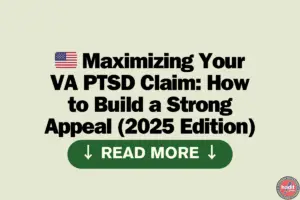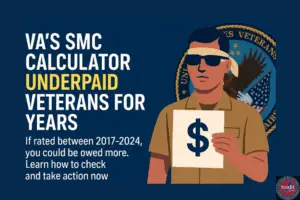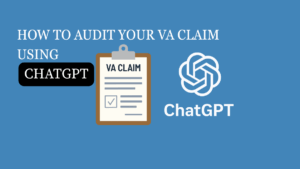The Veterans Affairs Servicing Purchase (VASP) Program is a new initiative by the Department of Veterans Affairs (VA) set to launch on May 31, 2024. This program aims to help veterans struggling with their mortgage payments keep their homes. The VASP program will allow the VA to purchase defaulted loans, modify them, and offer veterans more manageable repayment terms. This program is seen as a last-resort option for those facing severe financial difficulties and is part of the VA’s broader efforts to prevent foreclosures and support veterans.
Key Points
- The VASP program will start on May 31, 2024, and will help veterans in severe financial distress keep their homes.
- Veterans do not need to apply directly; servicers will identify eligible borrowers and submit requests on their behalf.
- The program offers modified loans with a fixed 2.5% interest rate, making payments more affordable for struggling veterans.
- Eligibility criteria include being 3 to 60 months delinquent on the loan, having a stable income, and occupying the property.
- The VASP program is part of the VA’s broader strategy to prevent foreclosures and provide long-term support to veterans.
Overview of the Veterans Affairs Servicing Purchase Program

The Veterans Affairs Servicing Purchase (VASP) Program is a new initiative by the Department of Veterans Affairs (VA) aimed at helping veterans who are facing severe financial hardships. Launched as a last-resort tool, the program is designed to assist veterans who have defaulted on their VA loans and are at risk of losing their homes. The VASP program will officially start on May 31, 2024.
Purpose and Goals
The primary goal of the VASP program is to provide a safety net for veterans who cannot resolve their delinquency through traditional VA home retention options. By purchasing and modifying defaulted loans, the VA aims to offer veterans a stable payment plan at a fixed interest rate of 2.5%. This initiative will help around 40,000 veterans avoid foreclosure and maintain homeownership.
Key Features
- Fixed Interest Rate: Borrowers will benefit from a fixed 2.5% interest rate for the remainder of their loan.
- No Direct Application Needed: Veterans do not need to apply directly for the program; servicers will identify eligible borrowers and submit requests on their behalf.
- Loan Modification: The VA will purchase delinquent loans, modify them, and place them in the VA-owned portfolio as direct loans.
- Foreclosure Moratorium: The program is part of a broader effort that includes a foreclosure moratorium through May 31, 2024.
Target Audience
The VASP program specifically targets veterans who have defaulted on their VA loans and are not eligible for other VA loan assistance programs. This includes veterans who are facing severe financial hardships and are at the highest risk for foreclosure. The program aims to provide these veterans with an additional affordable payment option to help them keep their homes.
The VASP program is a crucial step in ensuring that veterans have the support they need to maintain homeownership, even in the face of financial difficulties.
Eligibility Criteria for the VASP Program
The Veterans Affairs Servicing Purchase (VASP) Program has specific eligibility criteria that must be met for a loan to qualify. These criteria ensure that the program assists those most in need and can benefit from the support provided.
Delinquency Requirements
To be eligible for the VASP Program, the loan must be between 3 and 60 months delinquent when submitted to the VA. This means the borrower has missed payments for at least three months but not more than five years. Additionally, the loan can be submitted with or without a trial payment plan (TPP).
Property Ownership and Occupancy
The property in question must be owner-occupied, which means the borrower or an immediate family member must live in the home. Special considerations are made for situations like divorce or active military service. The borrower must also be the current legal owner of the property.
Income Stability and Bankruptcy Status
The borrower and any other obligors must have a stable and reliable source of income. This ensures they can resume making regular payments. Neither the borrower nor any other obligor should be in active bankruptcy when the loan is submitted. However, dismissed or discharged bankruptcies do not disqualify a loan from being reviewed for VASP.
The VASP Program is designed to help veterans keep their homes by providing a structured way to manage and modify their loans, ensuring long-term financial stability.
Types of Purchases Under the VASP Program
The Veterans Affairs Servicing Purchase (VASP) Program offers two main types of purchases to help veterans keep their homes: the Traditional VA Purchase (tVAP) and the VA Servicing Purchase (VASP). Each type has its unique features and processes.
Traditional VA Purchase (tVAP)
Under the tVAP, the VA reviews the loan on a case-by-case basis. This option is used when the VA decides it’s the best choice for both the veteran and the VA. Either the servicer or a VA technician can start the tVAP evaluation. The servicer does not check any loan criteria but sends the loan to the VA for review. The VA may consider tVAP after an assumption that the loan meets the general criteria and is in the VA’s best interest.
VA Servicing Purchase (VASP)
The VASP is a faster process in which the VA buys the loan and the servicer modifies it. The servicer checks if the loan meets the criteria and then completes the steps for the VA to buy and modify the loan. The loan must be between 3 and 60 months delinquent, the property must be owner-occupied, and the borrower must have a stable income and be able to make payments again.
Comparison Between tVAP and VASP
- Decision Maker: tVAP is decided by the VA, while the servicer handles VASP.
- Process Speed: VASP is quicker than tVAP.
- Criteria Check: tVAP does not require the servicer to check loan criteria, but VASP does.
- Loan Delinquency: VASP requires the loan to be delinquent for 3 to 60 months.
The VASP Program is designed to help veterans in severe financial hardship by offering different purchase options to keep their homes.
Loan Modification and Repayment Terms

The Veterans Affairs Servicing Purchase (VASP) Program offers several loan modification and repayment options to help veterans keep their homes. These options are designed to make monthly payments more affordable and prevent foreclosure. Here are the key aspects of the loan modification and repayment terms under the VASP Program:
Fixed Interest Rate
Loans modified under the VASP Program are set to a fixed interest rate of 2.5%. This ensures that veterans have predictable monthly payments over the loan’s life.
Repayment Period Options
The VASP Program provides two main repayment period options:
- 360 months (30 years): This is the standard repayment period.
- 480 months (40 years): If the 30-year term does not reduce the principal and interest portion of the monthly payment by at least 20%, the term can be extended to 40 years.
Trial Payment Plans
A Trial Payment Plan (TPP) is required in certain situations, such as when the loan is 24 months or more delinquent. The TPP consists of three payments that must be made on time. If the borrower completes the TPP, the servicer can then submit a request to VA for VASP payment. If the TPP is failed, the servicer can proceed with delinquent loan servicing.
Once the VASP payment from VA has been completed and certified, the servicer can prepare the appropriate loan modification documents and send them to the necessary parties for execution.
Implementation and Oversight
Role of Servicers
Servicers are crucial in the Veterans Affairs Servicing Purchase Program (VASP). They are responsible for helping veterans manage their loans and avoid foreclosure. Servicers must continue efforts to resolve any borrower’s delinquency during the targeted moratorium. They also need to evaluate borrowers who previously received COVID-19 relief to see if they still qualify for such relief.
VA’s Automated Review Process
The VA uses an automated review process to ensure that all applications and modifications meet the required standards. This process helps quickly identify any issues and ensures that veterans receive the assistance they need without unnecessary delays. The automated system checks for compliance with the program’s guidelines and helps maintain a high level of accuracy.
Post-Audit Procedures
After the initial review and approval, the VA conducts post-audit procedures to ensure ongoing compliance. These audits help identify discrepancies and ensure the program is being implemented as intended. Post-audit procedures are essential for maintaining the integrity of the VASP program and ensuring that veterans receive the benefits they are entitled to.
The VA’s commitment to thorough oversight ensures that veterans and their families receive the support they need to maintain financial stability and avoid foreclosure.
Impact on Veterans and Their Families
Foreclosure Prevention
The Veterans Affairs Servicing Purchase (VASP) program is designed to help veterans avoid losing their homes. The program provides a safety net for those facing financial difficulties by purchasing defaulted loans and modifying their terms. This initiative will assist around 40,000 veterans, troops, and family members.
Financial Stability
VASP aims to offer veterans a more stable financial future. With a fixed 2.5% interest rate, veterans can easily manage their payments, reducing the risk of further financial strain. This stability is crucial for veterans who have faced economic challenges, especially post-pandemic.
Long-Term Benefits
The VASP program’s long-term benefits are significant. Veterans can maintain homeownership, a key factor in overall well-being and stability. Additionally, the program is projected to save the government $1.5 billion over the next decade by preventing costs associated with homelessness and federal loan defaults.
The VASP program is a lifeline for veterans, ensuring they have the support needed to keep their homes and maintain financial stability.
Challenges and Criticisms of the VASP Program
Moral Hazard Concerns
One of the main criticisms of the Veterans Affairs Servicing Purchase (VASP) Program is the potential for moral hazard. Critics argue that the program might intentionally encourage veteran borrowers to become delinquent to benefit from the lower 2.5% interest rate. This could lead to a situation where veterans not in severe financial distress might still choose to default on their loans.
Operational Issues
The implementation of the VASP program has faced several operational challenges. Since its launch, there have been reports of increased risks of fraud, waste, and disruptions to operations. These issues have raised concerns about the program’s efficiency and effectiveness in helping veterans avoid foreclosure.
Legislative and Political Reactions
The VASP program has also sparked significant legislative and political reactions. Some lawmakers have questioned the program’s fiscal responsibility and its long-term sustainability. During a recent hearing, some members of Congress expressed concerns that the program might not be the best solution for all veterans and suggested alternative loss mitigation tools, such as a permanent partial claim option.
The VASP program, while designed to help veterans in severe financial hardship, has faced criticism and challenges that need to be addressed to ensure its success and sustainability.
Conclusion
The Veterans Affairs Servicing Purchase (VASP) program is a crucial safety net for veterans facing severe financial difficulties. By offering a fixed 2.5% interest rate and taking over delinquent loans, the VA aims to help veterans keep their homes. This program is a last resort, only available when other options have been exhausted. With VASP, the VA continues its long-standing commitment to supporting veterans and their families, ensuring they have a stable and secure place to live.
Frequently Asked Questions
What is the Veterans Affairs Servicing Purchase (VASP) Program?
The VASP Program is a new initiative by the Department of Veterans Affairs to help veterans who are struggling financially to keep their homes. Starting on May 31, 2024, the VA will buy defaulted VA loans, modify them, and manage them directly to prevent foreclosure.
Who is eligible for the VASP Program?
Veterans who have defaulted on their home loans, are facing severe financial hardships, and cannot resolve their delinquency through other VA home retention options are eligible. The loan must be between 3 and 60 months delinquent, and the property must be owner-occupied.
What are the main features of the VASP Program?
The program offers a fixed 2.5% interest rate for the remainder of the loan, and veterans do not need to apply directly. Instead, servicers will identify eligible borrowers and submit requests on their behalf.
How does the VASP Program help prevent foreclosure?
The VASP Program purchases and modifies defaulted loans, providing veterans with a stable and affordable payment plan, reducing the risk of foreclosure, and helping them keep their homes.
What types of loans are included in the VASP Program?
The program includes two types of purchases: Traditional VA Purchase (tVAP) and VA Servicing Purchase (VASP). Both options are reviewed based on available home retention options, and borrowers cannot choose between them.
Are there any criticisms of the VASP Program?
Some critics argue that the program might encourage veterans to become delinquent to take advantage of the lower interest rates. Others have raised concerns about operational issues and the need for additional legislative support.





